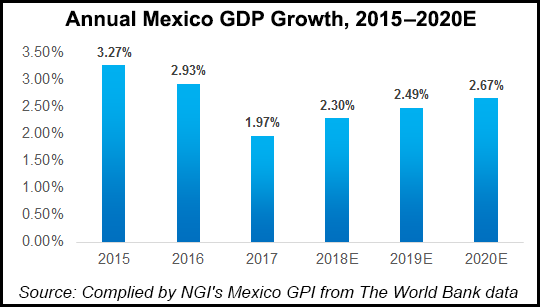Markets | Mexico | NGI All News Access | NGI Mexico GPI | NGI The Weekly Gas Market Report
The State of Mexico’s Natural Gas Market Today — Bonus Coverage
 Editor’s Note: Please enjoy this bonus coverage from NGI’s Mexico Gas Price Index, which includes daily prices, analysis and coverage of the emerging natural gas market in Mexico.
Editor’s Note: Please enjoy this bonus coverage from NGI’s Mexico Gas Price Index, which includes daily prices, analysis and coverage of the emerging natural gas market in Mexico.
Request a Trial | Subscribe

Editor’s Note: NGI’s Mexico Gas Price Index, a leader tracking Mexico natural gas market reform, is offering the following column as the first in a regular series on understanding this process, written by Eduardo Prud’homme.
Prud’homme was central to the development of Cenagas, the nation’s natural gas pipeline operator, an entity formed in 2015 as part of the energy reform process. He began his career at national oil company Petroleos Mexicanos (Pemex), worked for 14 years at the Energy Regulatory Commission (CRE), rising to be chief economist, and from July 2015 through February served as the ISO Chief Officer for Cenagas, where he oversaw the technical, commercial and economic management of the nascent Natural Gas Integrated System (Sistrangas).
The opinions and positions expressed by Prud’homme in the following column do not necessarily reflect the views of NGI’s Mexico Gas Price Index.
The far-reaching energy reform put into place between 2013 and 2014 in Mexico entailed a promise: that the opening to private investment and the promotion of competition in the only sector that had remained closed in Mexico would lead to greater growth, more jobs and lower prices of electricity, natural gas for domestic use and gasoline.
Among many factors that explain last year’s electoral defeat of the political group that promoted the opening of the energy sector is the failure of that promise. An abrupt increase in the price of gasoline in January 2017 — the “gasolinazo” — caused widespread anger and invalidated the energy reform in the eyes of the public. The advances and benefits that were achieved as a result of the reform became invisible, its relevance limited to specialized groups.
In the natural gas sector, the creation of an independent organization such as pipeline operator Centro Nacional de Control del Gas Natural (Cenagas) and the substantial growth in the length and capacity of the gas pipeline network that runs through the country have also gone largely unnoticed.
But the changes have been crucial and vast. For the first time, decades after the opening to private investment in 1995, the main pipeline system in Mexico offers open access to third parties, firm capacity is being assigned through an open season, and the decoupling of the molecule and transport services (unbundling) has been achieved.
To read the full article and gain access to more in-depth coverage including natural gas price and flow data surrounding the rapidly evolving Mexico energy markets, check out NGI’s Mexico Gas Price Index.
© 2024 Natural Gas Intelligence. All rights reserved.
ISSN © 1532-1231 | ISSN © 2577-9877 | ISSN © 2577-9966 | ISSN © 1532-1266 |
